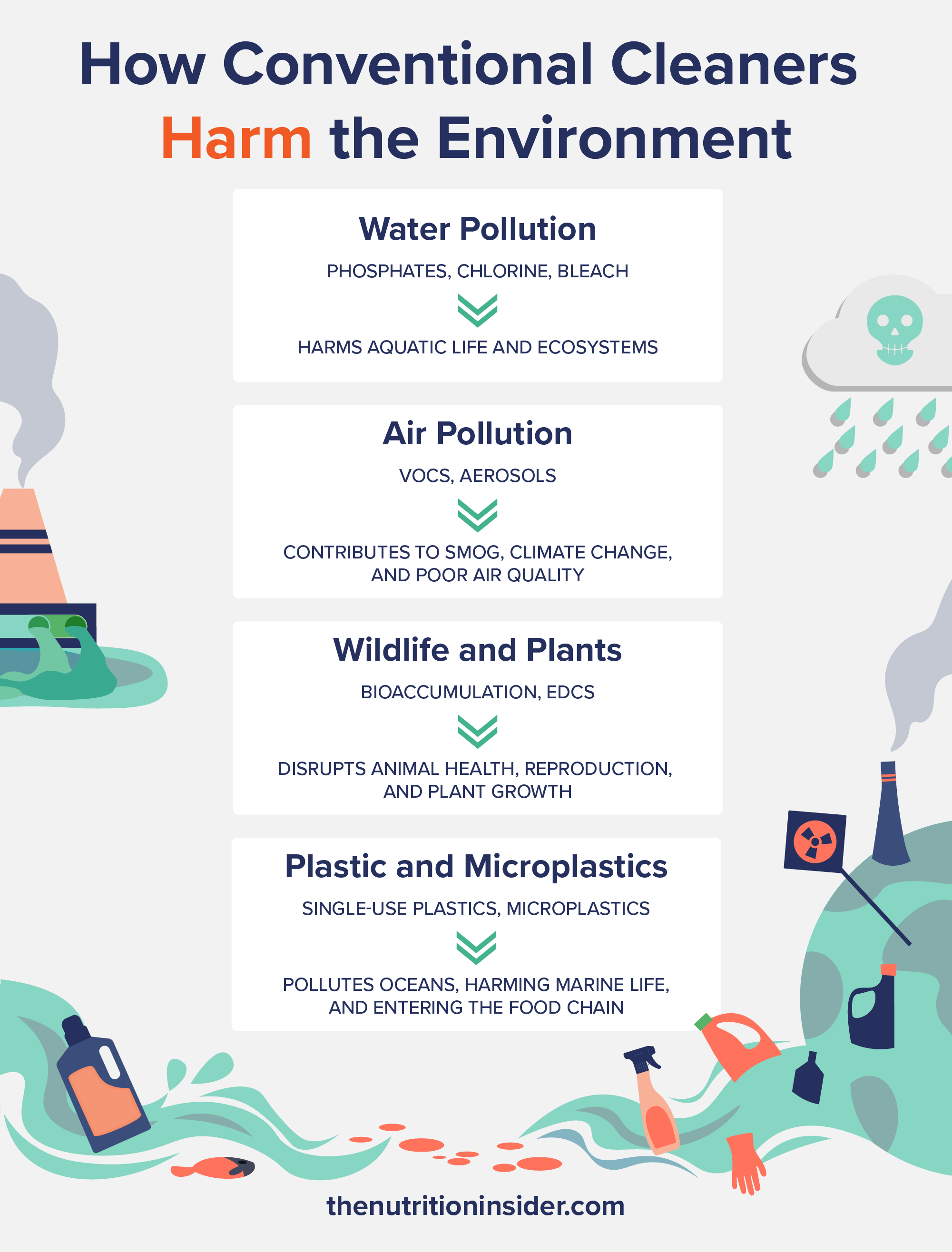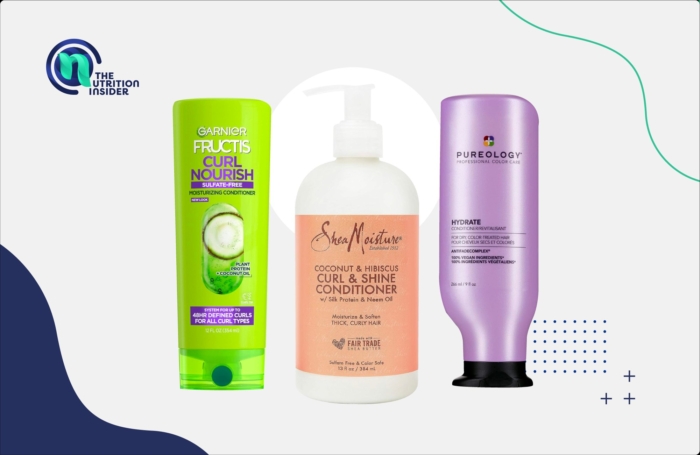This post contains links through which we may earn a small commission should you make a purchase from a brand. This in no way affects our ability to objectively critique the products and brands we review.
Are Cleaning Products Bad for the Environment?
Evidence Based Research To fulfill our commitment to bringing our audience accurate and insightful content, our expert writers and medical reviewers rely on carefully curated research.
Read Our Editorial Policy
Everyone loves a clean and tidy home—but many of the products that make our kitchens and bathrooms sparkly clean can have significant effects on both the environment and human health.
Conventional cleaning products contain chemicals that are bad for the environment in various ways, including effects on water contamination, air pollution, harm to wildlife and plants, climate change, and more.
In this article, learn more about how conventional household cleaning products can harm the environment—and check out this article if you want to know more about their effects on our health.
How Conventional Household Cleaners Harm the Environment

1. Water Pollution
Cleaning products and chemicals can contaminate the water supply through various pathways—mainly by entering wastewater systems when detergents, toilet cleaners, and other chemicals are rinsed down household drains while cleaning.
Although they enter municipal wastewater treatment systems, not all of the chemicals can be removed during the water treatment processes, which varies depending on the infrastructure and abilities of each specific treatment facility. As a result, cleaning chemicals can remain in the treated water and enter rivers, lakes, and oceans (as well as our drinking water).
When cleaning outdoors (like washing the car or cleaning in the backyard), chemicals can wash down into storm drains, where they flow directly into rivers, lakes, or oceans and contaminate these natural bodies of water.
Some of the cleaning product chemicals that are most harmful to water and aquatic life include:
- Phosphates: Found often in laundry detergent and dishwasher soap, phosphates contribute to eutrophication—when a body of water becomes excessively enriched with nutrients like phosphorus. When phosphates enter rivers, lakes, estuaries, or oceans, they act as nutrients for algae, causing excessive algal blooms. Algal blooms then reduce oxygen levels in the water, suffocating aquatic life and disturbing the balance of ecosystems.
- Chlorine and Bleach (Sodium Hypochlorite): Chlorine-based cleaners like bleach can react with other substances in water (typically during water treatment processes) to form harmful “disinfection by-products” (DPBs) like trihalomethanes (THMs), which are carcinogenic.1 When these DPBs reach natural water sources, they may harm both aquatic life and human health.
- Surfactants: These are compounds used in many cleaners to break down dirt and grease, so they’re commonly found in detergents, dish soaps, floor cleaners, and pretty much anything that says it’s a “grime fighter” or “tough on grease.” Many surfactants used in conventional products biodegrade very slowly or transform into more toxic chemicals, threatening aquatic life.2
- Ammonia: Ammonia is a common ingredient in conventional cleaning products (glass cleaners, floor cleaners, disinfecting sprays, bathroom cleaners, multi-purpose sprays, and more) that can be harmful to marine organisms if it reaches bodies of water—especially fish.3 Ammonia also promotes algae growth, worsening the problem of eutrophication.
2. Air Pollution
Conventional household cleaners can also harm the environment through air pollution, as many products release volatile organic compounds (VOCs), including oven cleaners, air fresheners, floor polish, bleach products, single-use disinfectant wipes, detergents, and more.
VOCs evaporate into the air at room temperature, contributing to poor indoor air quality. They also contribute to the formation of ground-level ozone—a key component of smog—which can cause a greenhouse gas effect and contribute to climate change.4
Cleaning chemicals in aerosol form also contribute to air pollution and can harm your lungs and respiratory system when they accumulate in indoor air.
3. Harms Plants and Wildlife
Through direct exposure to numerous chemicals, habitat contamination, or the disruption of ecosystems from water or air pollution, plants and animals can be harmed by household cleaning products.
Aquatic and marine life are particularly impacted for the reasons mentioned above in the water contamination section.
Some chemicals can bioaccumulate in animals, leading to health issues or even death. This is especially true for larger or predatory species that continually consume smaller animals with these chemicals, leading to buildup in their larger bodies over time.
Plants are also impacted when cleaning products are disposed of on the ground, where the chemicals can leach into the soil and affect plant life. Chemicals like bleach, ammonia, and synthetic surfactants can also alter soil chemistry, making it more difficult for plants to absorb nutrients.
Certain chemicals in cleaning products are known as endocrine-disrupting chemicals (EDCs). In addition to harming human hormonal and reproductive health, they can also interfere with the hormonal systems of animals—especially reptiles, fish, and amphibians.5 When these animals consume EDCs and experience hormonal disruption, a species’ survival can ultimately be affected due to abnormal reproduction.
In addition to EDCs threatening survival, other toxic household chemicals that accumulate in aquatic ecosystems can kill fish or amphibians, leading to a loss of biodiversity and potentially even extinction.
4. Plastic Waste and Microplastics
Many cleaning products come in single-use plastic containers, which, on their own, are harmful to the environment—but they also contain microplastics. These tiny fragments of plastic (which are increasingly ubiquitous in our modern lives) break down from plastic packaging and enter water systems.
Through the mechanisms mentioned above, microplastics can enter water systems and be ingested by marine life, causing harm to both the animals and, eventually, humans that may eat them.6
Are Cleaning Products Bad for the Environment FAQs
Do cleaning products pollute the air?
Yes, many cleaning products contain dangerous chemicals that can pollute the air (both indoor and outdoor air). Conventional household cleaners can also harm the environment through air pollution, as many products release volatile organic compounds (VOCs), including oven cleaners, air fresheners, floor polish, bleach products, single-use disinfectant wipes, laundry detergents, and more.
How long do cleaning chemicals stay in the air?
It depends on several factors, including what cleaning chemicals were used, the environment (ventilation, temperature, and humidity all play a role), and the method used (sprays, liquids, aerosols). VOCs can remain in the air for hours to days, depending on the concentration and ventilation of the space. Some VOCs like formaldehyde or benzene can persist even longer, especially in poorly ventilated areas. Aerosol particles typically remain for minutes to hours, and gas-based cleaners like ammonia and bleach can remain for hours. Opening windows or using air purifiers can help speed up the process.
What are the least toxic cleaning products?
The least toxic cleaning products typically contain ingredients you can find in your kitchen, like white vinegar, baking soda, and lemon juice. The “green” cleaning industry is becoming significantly more popular and widespread, so it’s easier to find non-toxic cleaning products now in most stores. You can search for non-toxic cleaning supplies on the EPA’s (Environmental Protection Agency) site here.
What are the disadvantages of using natural cleaning agents?
The only possible disadvantages of natural or green cleaning products are the potentially higher price and the fact that some green products may not work quite as well as their chemical-laden counterparts. But adding a little bit more elbow grease to your cleaning regimen is a small price to pay for saving the environment (and your health), right?
- Evlampidou, I., Font-Ribera, L., Rojas-Rueda, D., Gracia-Lavedan, E., Costet, N., Pearce, N., Vineis, P., Jaakkola, J. J. K., Delloye, F., Makris, K. C., Stephanou, E. G., Kargaki, S., Kozisek, F., Sigsgaard, T., Hansen, B., Schullehner, J., Nahkur, R., Galey, C., Zwiener, C., Vargha, M., … Villanueva, C. M. (2020). Trihalomethanes in Drinking Water and Bladder Cancer Burden in the European Union. Environmental health perspectives, 128(1), 17001. https://doi.org/10.1289/EHP4495
- Badmus, S. O., Amusa, H. K., Oyehan, T. A., & Saleh, T. A. (2021). Environmental risks and toxicity of surfactants: overview of analysis, assessment, and remediation techniques. Environmental science and pollution research international, 28(44), 62085–62104. https://doi.org/10.1007/s11356-021-16483-w
- U.S. Environmental Protection Agency. (2024). Ammonia. https://www.epa.gov/caddis/ammonia
- U.S. Environmental Protection Agency. (2024). Ground-level Ozone Basics. https://www.epa.gov/ground-level-ozone-pollution/ground-level-ozone-basics
- Ortiz-Zarragoitia, M., Bizarro, C., Rojo-Bartolomé, I., de Cerio, O. D., Cajaraville, M. P., & Cancio, I. (2014). Mugilid fish are sentinels of exposure to endocrine disrupting compounds in coastal and estuarine environments. Marine drugs, 12(9), 4756–4782. https://doi.org/10.3390/md12094756
- Campanale, C., Massarelli, C., Savino, I., Locaputo, V., & Uricchio, V. F. (2020). A Detailed Review Study on Potential Effects of Microplastics and Additives of Concern on Human Health. International journal of environmental research and public health, 17(4), 1212. https://doi.org/10.3390/ijerph17041212








